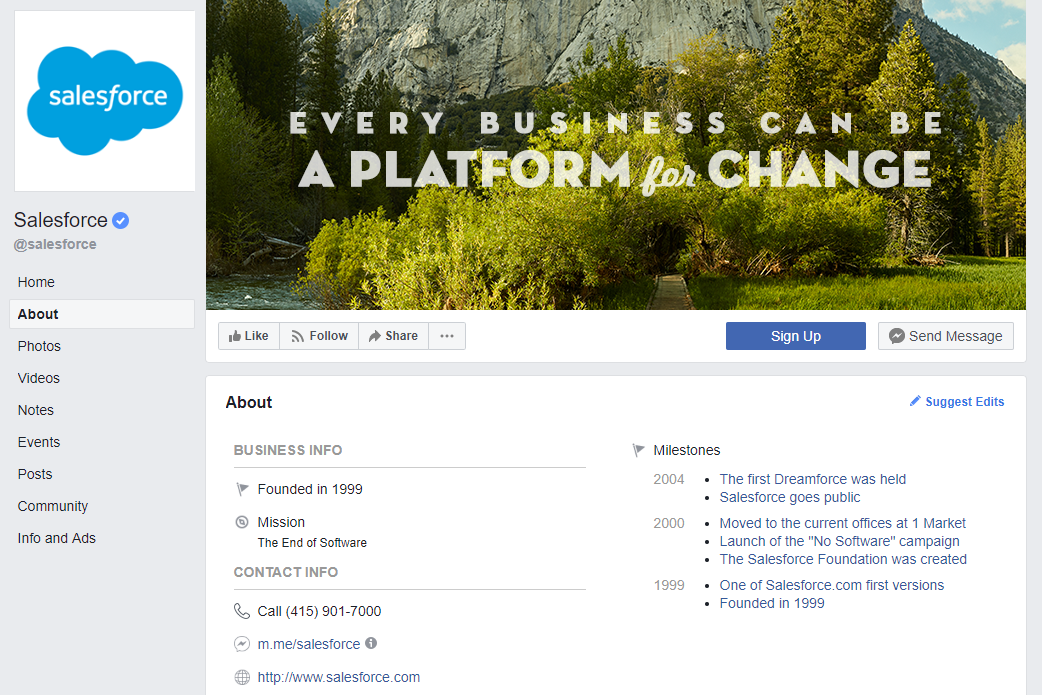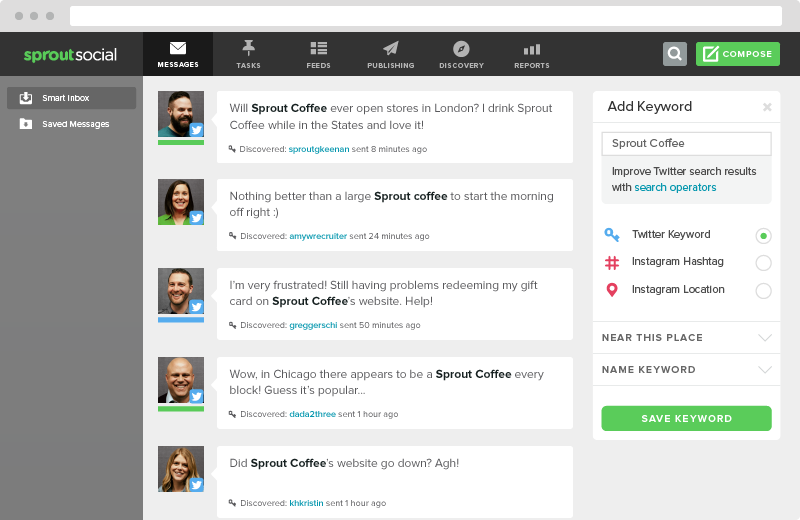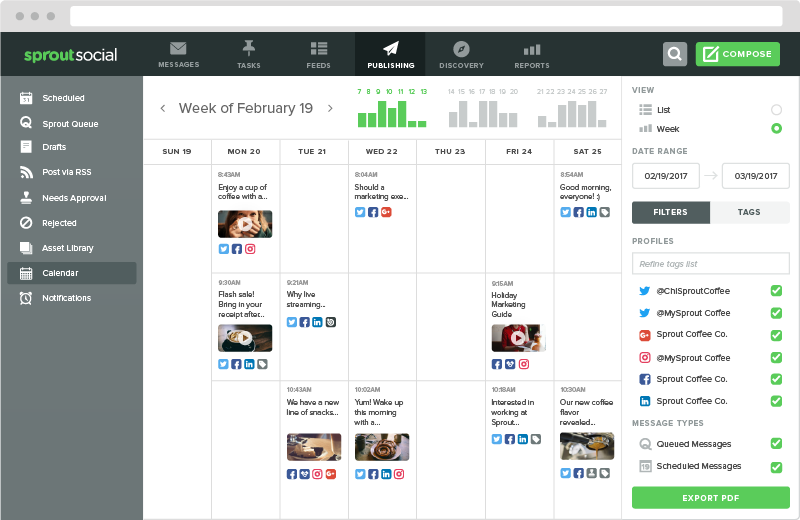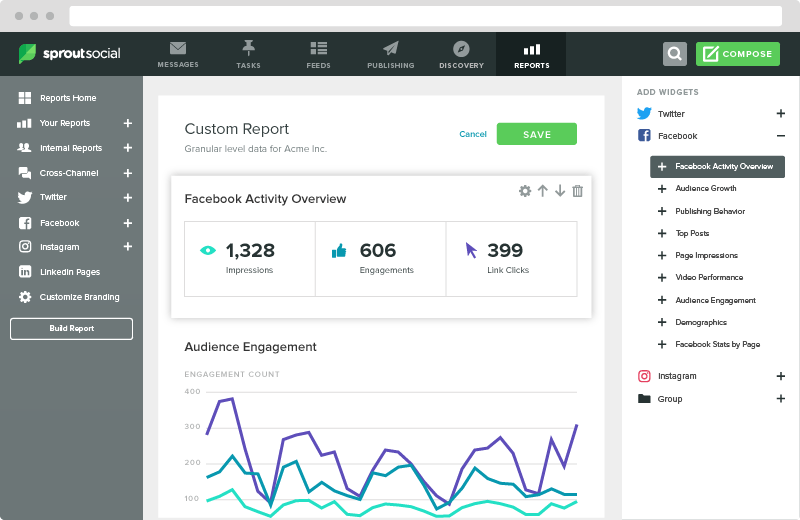If you’re trying to wrap your head around modern social media, chances are you’re a bit overwhelmed.
Hey, we totally get it.
It’s a lot to take in, especially since the social space is almost unrecognizable from what it was a decade ago.
Back then, you might see the occasional business profile. Fast forward to present day where a social presence is an expectation for businesses, with 80% of marketers relying on social media to raise brand awareness.
And if you feel like you’re late the game, there’s no need to panic.
To help get your feet wet, we’re taking things back to the basics.
If you’re starting from scratch, the following list of social media marketing basics can help get your presence off the ground. Whether you’re interested in social selling, customer service or anything in-between, this guide will get the ball rolling.
Plus, we’ve compiled these tips into a handy checklist to get you started:
1. Pick your social channels
First things first: how do you decide where your business needs to be?
Bigger brands with large customer bases tend to have presences across multiple platforms. Giants like McDonald’s and Starbucks obviously have the resources to be everywhere at once, but what if you’re a small business?
For the sake of narrowing down where you should spend your time, below is a quick overview of each of the major social platforms. Rather than try to dominate them all, you should consider which platforms make the most sense based on your industry and audience.
Simple and straightforward, Twitter is a solid starting point for most businesses. Requiring minimal setup and providing a place to go back-and-forth with followers directly, there’s reason why Twitter remains the go-to platform for customer service. If you’re trying to master the social media marketing basics of hashtags, tagging and social media etiquette, look no further.
We’re thinking more ice cream might solve your problem. 🙃
— Halo Top (@HaloTopCreamery) October 15, 2018
Undoubtedly the biggest name in social, Facebook is somewhat of a mixed bag for business. The platform’s recent algorithm change has made it difficult for some businesses to grow their Pages and stay in touch with fans consistently.
That said, Facebook’s ad platform is the gold standard for social media ads if you’re interested in paid promotions. On a similar note, Facebook a must-have for brick-and-mortar businesses looking to target local customers. Allowing for check-ins and reviews, it’s a prime place to grow a dedicated local following.
To keep the Bears season going strong during the bye week, all of Chicago is required to eat at least one 🌭 today. Bonus points if it’s a Superdawg ☝️🏈😄
Posted by Superdawg on Sunday, October 7, 2018
At its core, Instagram is a network centered around visual content. A major hub for brick-and-mortar businesses, ecommerce shops and influencers alike, the platform encourages brands to get creative. From eye-popping photos to clever captions, it’s all about finding unique ways to show off what you’re selling.
LinkedIn is a network laser-focused on business trends and networking. Although most business profiles primarily belong to startups, LinkedIn is a goldmine for anyone networking in the B2B space. Looking to get in touch with an influencer, marketing manager or CEO? Chances are you can find them here.

This visual pinning platform is insanely popular with millennials and is noted to be one of the best networks for social selling. Not unlike Instagram, Pinterest thrives on imagery and inspirational content where products serve as the proverbial centerpiece.

YouTube
Although some might not regard YouTube as a traditional social network, the platform’s active and engaged community speaks for itself. Considering that video represents the top-performing type of content across nearly every social networking, YouTube is a great place to house your videos if you’re already producing them.
And if your head is still spinning with choices and you’re not sure where to start, ask yourself: where are your competitors and audience hanging out?
2. Complete your profile(s)
Among the most important social media marketing basics is the need to fill out your profile 100%.
Not only does make your profile look more professional, but also makes your business easier to find.
Think about it. Social media results are often among the first to pop up for any given small business on Google.
By totally filling out your profiles with your business’ name, address and other essential information, you become much easier to find in a Google or native social search.
While each network has its own specifics and quirks, here are some pointers to consider when filling out your profiles.
Claim your business’ name and URLs
If your business has a unique name that’s a reasonable number of characters (think: sixteen or less), you probably don’t have to think twice about your URL choice.
That said, you do need to make a point to use a consistent URL if you’re signing up across multiple platforms. Note that big brands like Denny’s (@dennysdiner) and Nikon (@NikonUSA) do this to prevent any confusion for fans and followers.
You can use a tool like NameChk to both brainstorm and confirm that your name of choice is available.
Choose images and brand creatives
From profile pictures to cover photos, it’s important that your business profile looks the part.
If you’re using existing brand creatives, take a peek at our guide to social image sizes to guarantee your photos are optimally sized. There’s nothing worse than a grainy photo to make you look unprofessional.
And if you need to create social photos from scratch, look into tools like Canva which boasts tons of pre-made social image templates.

Fill in your bios and “About” sections
Using appropriate messaging, fill in as many details about your business as you possibly can.
Again, people oftentimes hit up social media results before checking your website. As a result, keeping your contact information or hours up-to-date is essential.

3. Follow fellow businesses, brands and prospects
You won’t get much out of your social presence if you’re a total island.
Following others shows that you’re an active participant in the social space versus a profile that’s just blasting its own content. Whether it’s competitors, fellow industry leaders or even prospects, make a point to follow fresh profiles to see how others operate on social media.
Most networks offer up some sort of follower suggestions to get you started.

If nothing else, following other profiles can give you some much-needed inspiration as you’re learning your social media marketing basics.
4. Keep a close eye on your mentions
Before you get in too deep into worrying about followers in content, make sure that you have an ecosystem for monitoring mentions and notifications.
Customer concerns. Shout-outs from a fan. A new follow from an influencer.
Timeliness is so important when it comes to responding to these touchpoints, especially when it comes to customer service.
Hey, there! We just responded via DM. You should be able to just change the dates/times when you edit these drafts into the order you’d like them to appear.
— Sprout Social (@SproutSocial) October 15, 2018
If you’re juggling multiple platforms, tools such as Sprout’s Smart Inbox are invaluable. By aggregating both direct replies and untagged mentions of your business, you never miss an opportunity to interact with fans and followers no matter what their comment might be.

5. Define your content strategy
Now that your profiles are set up, you’re going to need to decide what you’re going to post on a day-to-day basis.
Coming up with a content strategy might seem like a lot of legwork, but it all really boils down to your goals.
- Looking to educate your audience in the B2B space? Publish content, news and opinions relevant to your industry.
- Trying to push ecommerce products? Post action shots of your products and photos of others showing off your swag.
- Focused on customer service? Tips, shout-outs and company updates are totally fair game.
Regardless of what you might be posting, coming up with a hashtag to couple with your content is a brilliant branding move.
Hashtags can be used to not just to get your attention, but also encourage people to share their photos interacting with your brand. Here’s a good example from KitchenAid and their #ForTheMaking tag where fans show off their latest culinary creations.
6. Assemble your content calendar
For the sake of saving time, knowing in advance what you’re going to post and when you’re going to post is in a major point in your favor. This also keeps you from posting the same pieces of content again and again.
But as evidenced by our best times to post on social, brands have a lot of ground to cover in terms of frequency and how much content to push.
With the help of Sprout’s scheduling and publishing, you can house your social posts, captions and creatives in one place. By allowing you to tap into the optimal times for engagement, you can automate the most tedious aspects of your social presence without having to worry about posting in real time.

7. Engage with others (hint: don’t do all the talking)
Don’t forget: social media isn’t all about you.
From commenting on posts to retweeting and publishing the content of others, getting noticed on social media means being an active participant. Interacting with fans and customers allows you to show off your personality and likewise introduce your brand to new followers.
Make a point to interact with at least a few profiles per day. Focusing on relationships and engagement via social only takes a few seconds and can score you major brownie points with your followers.
8. Find your brand voice
Speaking of personality, one of the best ways to stand out via social is to define your distinct brand voice.
For example, it’s all-the-rage for many big box brands to take a sassy or otherwise sarcastic tone with their fans.
You have no idea how many times this has happened. No respect
— Helper (@helper) October 12, 2018
Of course, you’re not required to adopt the same sort of tone yourself. The key is present yourself as human rather than a robot. “Getting real” with followers is common practice these days, so don’t be afraid to crack jokes or have a heart-to-heart with your follower when appropriate.
9. Promote your social channels
Let’s say you have all of your social profiles squared away.
Great! Now, how do you expect followers to find you?
Don’t make the mistake of confining your social presence solely to social media. Some additional places and you can hype up your profiles include:
- Your email newsletter, footers and signatures
- Your site headers and footers
- Cross-promotion between social sites (think: promoting your YouTube channel on Twitter)
- In-person via signage and business cards

10. Monitor your social presence for growth
Getting the many moving pieces of your social presence up and running is a huge relief.
However, your job’s not quite done yet.
To guarantee that you get in front of as many customers as possible, monitoring your growth is a major must-do. With Sprout, social reports can clue you in on everything from your top-performing content to how engaged your audience is. These reports are crucial for accountability and guaranteeing your numbers continue to tick upward.

Have you mastered these social media marketing basics?
This social media checklist represents a roadmap for businesses looking to start their presence from scratch. While all of the trends and terminology might be jarring, chances are you have more than what it takes to master the basics.
You can keep track of your social progress with our checklist of all the tips in this article:
We still want to hear from you, though. What’s the hardest part about starting out on social? Any social media marketing basics we missed? Let us know in the comments below!